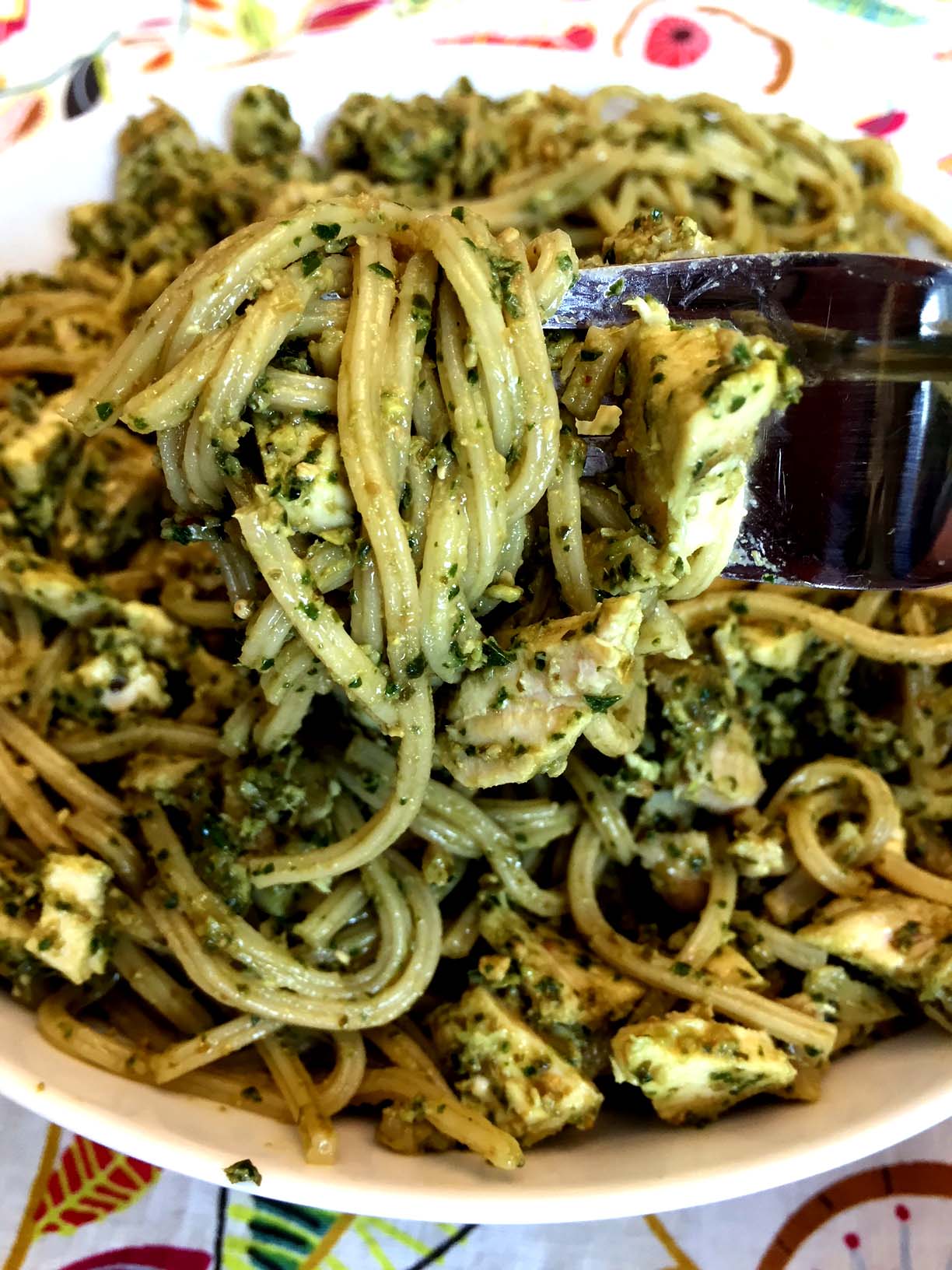
Slice the chicken breasts in half and serve with the tomatoes and chilli spooned over the top.Return the pasta, beans and spinach to the pan, pour in the pesto from the processor and stir together, loosening with splashes of cooking water until silky. Stir the spinach into the pasta pan, then drain, reserving a cupful of the starchy cooking water.Halve or quarter the tomatoes, add to the chicken and give the pan a shake. Slice the lasagne sheets up into random handkerchief shapes and add to the beans to cook for a couple of minutes.Blitz until smooth, adding a ladle or two of cooking water from the beans to loosen, then season to taste. Squash in the unpeeled garlic through a garlic crusher.Pick a few basil leaves for garnish, then rip off the stalks and put the rest of the bunch into the processor with the almonds, Parmesan, extra virgin olive oil and lemon juice.Line the beans up and cut off the stalks, put into the casserole pan, cover with boiling salted water and cook for 6 minutes with the lid on.

Put the chicken into the frying pan with the rapeseed oil, the bashed unpeeled garlic cloves and halved chillies, turning after about 3 or 4 minutes, until golden and cooked through.Fold over the paper, then bash and flatten the chicken to 1.5cm thick with a rolling pin. These recipe steps apply irrespective of what type of pesto you are using – basil, rocket/arugula, spinach etc – there’s a nice list of options in my homemade pesto recipe. The image below is a rocket/arugula and walnut pesto – I love the combination of the spicy rocket and slightly bitter walnuts.On a large sheet of greaseproof paper, toss the chicken with sea salt, black pepper, fennel seeds and the rosemary leaves. I actually haven’t used store bought pesto enough to know if it will turn black from heat. I’m sharing these tips on the assumption that you’re using a homemade pesto (basil or otherwise). 😭 Eat at room temp – that’s the best you can do. The best way to season Pesto Pasta is to salt the water.ĭO NOT REHEAT leftover pesto pasta! Again – black pesto. Salt the water – Pesto usually isn’t (and should not be) seasoned enough such that you don’t need to add any other salt once tossed through pasta. You will be surprised how much the pasta can absorb – I used 3/4 cup for 300g/10oz pasta for the spaghetti in the video (because I kept tossing to film and it kept sucking up the sauce!) Take out way more than you think you need, you might need it. Take out 1 cup of pasta cooking water just before you drain (not earlier, otherwise it’s not starchy enough). The heat from the pasta is ok – but if you add the heat from the pot, the basil won’t like it.ĭo not toss on the stove! Again – black basil. Toss in a bowl, not the pot you cooked the pasta in – basil doesn’t like heat. I say that pesto pasta is one of the simplest pastas to make, but I do have a few tips to share – lessons learned from my own mistakes! Twirls and other shapes with “crevices” rate lower just because there’s far more surface area so somehow, I just feel a bit pesto deprived. I find that it’s not quite as easy to toss the pesto through and the more you work the pasta, the less saucy it becomes (though you just keep adding pasta cooking water, but there’s only so much you can add).

Spaghetti and other thin(-ish) long strand pastas are my next favourite. I find it’s the easiest to toss for even distribution and you get the “juiciest” pesto pasta. My favourite is penne or ziti (which is just penne with a smooth surface). And even in today’s recipe video, I say to use your favourite pasta.īut I do have my preferences. You can make pesto pasta with any pasta your heart desires. Regular readers here are sick of reading about it – I write about it in every pasta recipe, from Shredded Beef Ragu to classic Bolognese, to Spaghetti Marinara!Īnd THAT is the secret to making a JUICY pesto pasta that’s slick with pesto sauce without adding tons and tons of extra oil! It’s the “proper” way to make pastas, a technique used in every Italian household and restaurants all over the world. Just like when you shake up salad dressings – same thing. The starch in the water emulsifies with the pesto, which simply means the fat in the pesto + starch in the water thickens. It will thin out the pesto so it coats everything nicely and creates a glossy pesto sauce that coats every bit of pasta. If you’ve ever made pesto pasta and found that it a bit on the dry side, then tried to salvage it by adding more and more olive oil only to end up with an excessively greasy pasta, you’ll love the technique I’m sharing today: Add pasta cooking water
Pesto pasta recipe how to#
How to make a JUICY pesto pasta with pesto sauce Anyone can make a Pesto Pasta, but not everyone knows how to make a pesto pasta that’s slick with plenty of pesto sauce without adding tons of extra oil! Here’s how I make it.


 0 kommentar(er)
0 kommentar(er)
